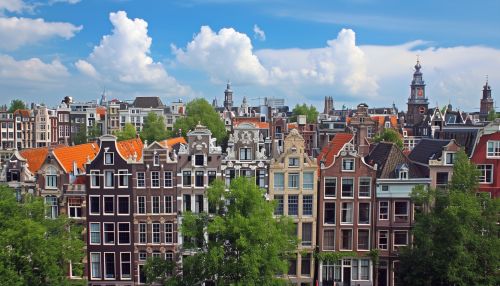Architecture of Amsterdam
History
Amsterdam, the capital city of the Netherlands, has a rich architectural history that dates back to the 13th century. The city's architecture is characterized by a variety of styles, ranging from the traditional Dutch gabled houses of the 17th century to the modernist designs of the 20th and 21st centuries.


The city's architectural development was largely influenced by its geographical location and economic growth. Amsterdam's location in a marshy river delta necessitated the construction of buildings on wooden piles, a technique that has been used since the city's inception and continues to be used today. The city's economic prosperity during the Dutch Golden Age in the 17th century led to a construction boom, resulting in the iconic canal houses and gabled facades that Amsterdam is known for.
Canal Ring
One of the most distinctive features of Amsterdam's architecture is its canal ring, a network of concentric, semi-circular canals that were dug in the 17th century during the Dutch Golden Age. The canal ring, also known as the "Grachtengordel", was added to the UNESCO World Heritage List in 2010 for its unique urban planning design and architectural value.
The canal houses that line the canals are a testament to the city's architectural and historical heritage. These houses were built by wealthy merchants and are characterized by their narrow, tall, and deep design. The facades of these houses are often adorned with ornate gables, a distinctive feature of Dutch Renaissance architecture.
Architectural Styles
Amsterdam's architecture is a blend of various architectural styles, each reflecting a different period in the city's history.
Dutch Renaissance
The Dutch Renaissance style, which emerged in the 16th century, is characterized by the use of symmetry, proportion, and ornamentation. This style can be seen in many of the city's oldest buildings, such as the Old Church and the New Church.
Dutch Classicism
The 17th century saw the rise of Dutch Classicism, a style that combined elements of the Renaissance with classical Greek and Roman architecture. This style is evident in many of the city's canal houses, which feature symmetrical facades, triangular pediments, and pilasters.
Amsterdam School
The Amsterdam School style emerged in the early 20th century as a reaction to the austere and functional architecture of the time. This style, characterized by its use of brick, complex shapes, and decorative details, can be seen in buildings such as the Scheepvaarthuis and the Het Schip.
Modernism
In the 20th and 21st centuries, Amsterdam embraced Modernism and Postmodernism, with architects such as Rem Koolhaas and Piet Blom contributing to the city's architectural landscape. Notable modern and postmodern buildings in Amsterdam include the Van Gogh Museum, the Stedelijk Museum, and the EYE Film Institute.
Future Developments
Amsterdam continues to evolve architecturally, with new developments and renovations taking place throughout the city. The city's architectural future is guided by its commitment to sustainability and innovation, with many new buildings incorporating green design principles and cutting-edge technology.
